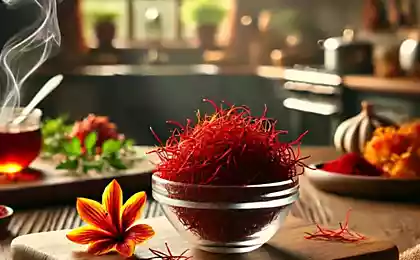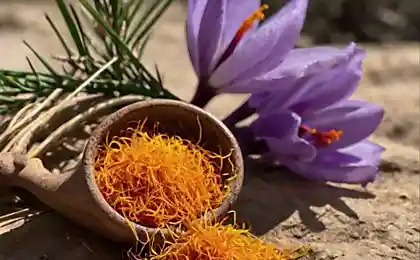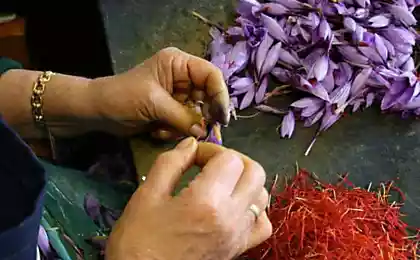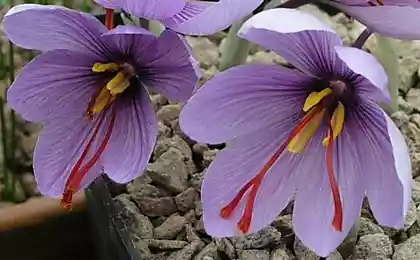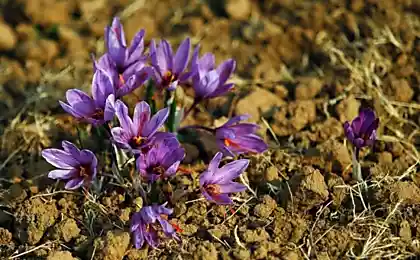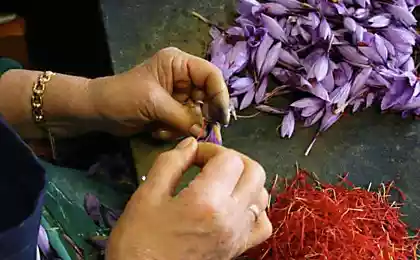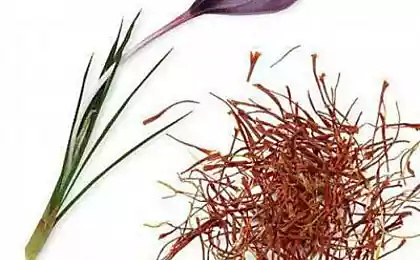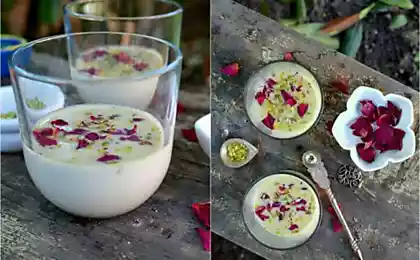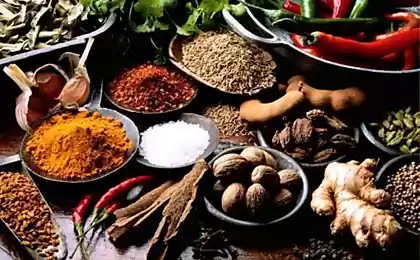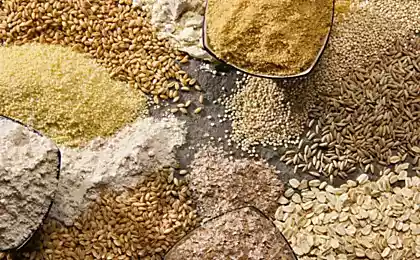420
The ancient healing power of saffron
In the flowers of the saffron seed from which the spice is made, there is something magical. If the beauty of the plants will fascinate the observer immediately, it will complement the delicate taste of spices.
Saffron is very expensive, because of the 150 flowers to obtain just 1 gram of dry seasoning, a pound of it costs about a thousand dollars. Its uniqueness is evidenced by the fact that the collection of saffron is not used mechanisms, all harvested by hand as it was done hundreds, and possibly thousands of years ago.
On each plant, no more than four edible flowers, each with three vivid crimson stigmas, producing a condiment. The sum comes out to twelve stigmas, which can be collected from 30 mg of fresh saffron. In dried form, this portion will weigh only 7 milligrams.
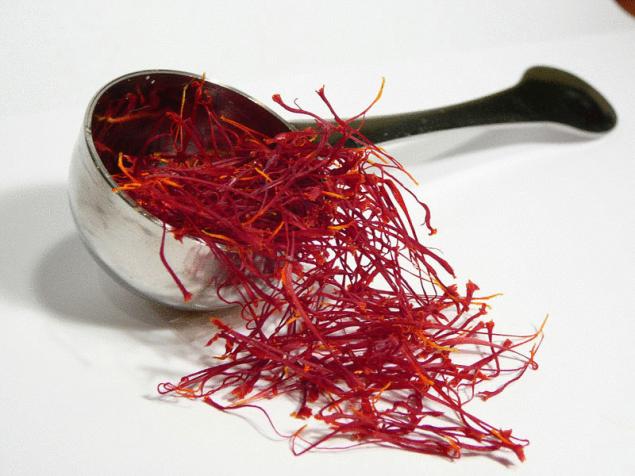
Saffron is used as a versatile medicine since ancient times. In 2004, Fira, island of the Aegean sea, the researchers studied the ancient frescoes, the age of which is about three and a half thousand years. One of them was the image of the goddess, the leading gathering of saffron and using it as medication.
Even more surprising, a survey by scientists of the prehistoric habitations in the North-West of Iran. Found there green paint talking about using him as a man since that is even hard to imagine.
Chemical composition of saffron is incredibly complex. In the plant contains more than one hundred and fifty volatile and aromatic compounds – a biochemical Symphony, a mystery which may remain unsolved until the end, because it defies the reductionism of modern pharmacology.
What kind of useful properties of this plant?
At the moment, the surge of interest in this seasoning due to its properties that help to drop weight (saffron appetite suppressant). But these properties are not restricted. The use of this plant promises much in the treatment of such neurodegenerative diseases as Alzheimer's.
Dagstidningarna randomized, double study of the efficacy of saffron in the treatment of mild to moderate forms of Alzheimer's disease showed that taking 15 mg of saffron twice a day as effective as using the drug "Donepezil" (Aricept) at a dose of 5 mg twice a day.
It should be noted that the use of saffron brings about much less side effects significantly reduced nausea. These results were published in 2010.
Another study that year, which lasted 16 weeks, also pointed to the effectiveness of the dosage of saffron 15 mg for the treatment of mild to moderate forms of Alzheimer's disease.
The use of petals saffron seed almost as effectively as the use of Prozac in treating depression. In 2007 in the publication Progress in Neuropsychopharmacology and Biological Psychiatry has been described that 15 mg of saffron petals as effective as 10 mg of Prozac in the treatment of mild to moderate forms of depression.
Moreover, 25 participants in the study achieved a complete remission. The results from another study indicate the efficacy of daily administration of 100 mg of saffron comparable to the effect of antidepressant "Imipramine" in the treatment of the above forms of depression.
Experimentally confirmed therapeutic effect of saffron in the treatment of the following diseases:
Saffron effectively heals wounds, has a calming, anti-inflammatory and anticarcinogenic actions. This plant is a good antidepressant, a reverse mutator, antioxidant and aphrodisiac.
It stimulates cellular processes, relaxes the respiratory system, protects the heart, can be used in Oncology, neurology, is able to reduce blood pressure and neutralize the action of prostaglandins and tumor necrosis factor alpha.
As with any plant with a wide range of biological effects, saffron is consumed with care. In small amounts, as when used in cooking, this seasoning will help to bring the body into balance or to make a difference in treatment.
"Pharmacological" dose, or a combination of prescription medicines carry a risk. So please be careful and consult your doctors first before applying high doses of saffron.
source: mixednews.ru
Source: /users/1077
Saffron is very expensive, because of the 150 flowers to obtain just 1 gram of dry seasoning, a pound of it costs about a thousand dollars. Its uniqueness is evidenced by the fact that the collection of saffron is not used mechanisms, all harvested by hand as it was done hundreds, and possibly thousands of years ago.
On each plant, no more than four edible flowers, each with three vivid crimson stigmas, producing a condiment. The sum comes out to twelve stigmas, which can be collected from 30 mg of fresh saffron. In dried form, this portion will weigh only 7 milligrams.

Saffron is used as a versatile medicine since ancient times. In 2004, Fira, island of the Aegean sea, the researchers studied the ancient frescoes, the age of which is about three and a half thousand years. One of them was the image of the goddess, the leading gathering of saffron and using it as medication.
Even more surprising, a survey by scientists of the prehistoric habitations in the North-West of Iran. Found there green paint talking about using him as a man since that is even hard to imagine.
Chemical composition of saffron is incredibly complex. In the plant contains more than one hundred and fifty volatile and aromatic compounds – a biochemical Symphony, a mystery which may remain unsolved until the end, because it defies the reductionism of modern pharmacology.
What kind of useful properties of this plant?
At the moment, the surge of interest in this seasoning due to its properties that help to drop weight (saffron appetite suppressant). But these properties are not restricted. The use of this plant promises much in the treatment of such neurodegenerative diseases as Alzheimer's.
Dagstidningarna randomized, double study of the efficacy of saffron in the treatment of mild to moderate forms of Alzheimer's disease showed that taking 15 mg of saffron twice a day as effective as using the drug "Donepezil" (Aricept) at a dose of 5 mg twice a day.
It should be noted that the use of saffron brings about much less side effects significantly reduced nausea. These results were published in 2010.
Another study that year, which lasted 16 weeks, also pointed to the effectiveness of the dosage of saffron 15 mg for the treatment of mild to moderate forms of Alzheimer's disease.
The use of petals saffron seed almost as effectively as the use of Prozac in treating depression. In 2007 in the publication Progress in Neuropsychopharmacology and Biological Psychiatry has been described that 15 mg of saffron petals as effective as 10 mg of Prozac in the treatment of mild to moderate forms of depression.
Moreover, 25 participants in the study achieved a complete remission. The results from another study indicate the efficacy of daily administration of 100 mg of saffron comparable to the effect of antidepressant "Imipramine" in the treatment of the above forms of depression.
Experimentally confirmed therapeutic effect of saffron in the treatment of the following diseases:
- Anxiety
- Asthenozoospermia (reduced sperm motility)
- Hypertrophy of the heart muscle
- Drug intoxication of the liver
- Colon cancer
- Diabetic neuropathy
- Dysmenorrhea
- Erectile dysfunction
- High pressure
Saffron effectively heals wounds, has a calming, anti-inflammatory and anticarcinogenic actions. This plant is a good antidepressant, a reverse mutator, antioxidant and aphrodisiac.
It stimulates cellular processes, relaxes the respiratory system, protects the heart, can be used in Oncology, neurology, is able to reduce blood pressure and neutralize the action of prostaglandins and tumor necrosis factor alpha.
As with any plant with a wide range of biological effects, saffron is consumed with care. In small amounts, as when used in cooking, this seasoning will help to bring the body into balance or to make a difference in treatment.
"Pharmacological" dose, or a combination of prescription medicines carry a risk. So please be careful and consult your doctors first before applying high doses of saffron.
source: mixednews.ru
Source: /users/1077
The British Parliament through the eyes of the servants
Garlic soup with 52 cloves of garlic can help to fight the cold, flu and even norovirus
